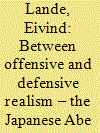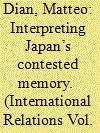| Srl | Item |
| 1 |
ID:
160695


|
|
|
|
|
| Summary/Abstract |
This article gives a broad description of the Japanese second Abe government’s reassurance, arming, and alliance policy toward China. The sources used are mostly elite interviews, newspaper articles, and books from Japan. It gives a realist analysis but also looks at New Komeito’s influence within the coalition government on topics such as the adoption of principles for collective self-defense. While retaining major elements of the defensive realist Yoshida Doctrine, the direction of policy change has been toward a more assertive policy. Japanese perceptions of China’s capabilities and intentions and of the offensive or defensive advantage of the geography of the Nansei Islands and Chinese anti-ship ballistic missiles give an explanation for the shift in policy.
|
|
|
|
|
|
|
|
|
|
|
|
|
|
|
|
| 2 |
ID:
139032


|
|
|
|
|
| Summary/Abstract |
In July 2014, Japanese Prime Minister Shinzo Abe announced that his cabinet had approved a reinterpretation of the country’s constitution. Although Article 9 of the document, effected in 1947, stated that Japan had forever renounced war as a sovereign right, the change meant that the Japanese Self- Defense Forces (JSDF) would, for the first time since their founding in 1954, be permitted to participate in acts of collective self-defence (generally understood to be the right to use force to repel an armed attack against a foreign country that has a close relationship with one’s own country). Abe’s historic plan sparked criticism from China and South Korea, two countries affected by Japanese aggression during the Second World War. Both countries issued warnings about the resurgence of Japanese militarism, amid growing concerns that both China and Japan were leading an arms race in East Asia.
|
|
|
|
|
|
|
|
|
|
|
|
|
|
|
|
| 3 |
ID:
167508


|
|
|
|
|
| Summary/Abstract |
Japan’s security discourse – despite accelerating shifts in its security stance over the last two decades, and more recently, under the Abe administration – remains dominated by views of essential continuity and maintenance of the “Yoshida Doctrine.” The case of Japan’s militarization of space is used to create a framework for systematically dismantling default assumptions about the durability of the Yoshida Doctrine. The militarization of space serves as a driver of broader trends in Japan’s security policy manifested in the procurement of dual-use assets in launch systems, communications and intelligence satellites, and counterspace capabilities necessary for active internal and external balancing with the US–Japan alliance; the strengthening domestically of security policymaking institutions; and the jettisoning of anti-militaristic norms. Japan’s increasingly assertive military stance, bolstering of the US–Japan alliance and cessation of hedging, facing down of China’s rise, and departure from the Yoshida Doctrine as grand strategy are thus revealed as hiding in plain sight.
|
|
|
|
|
|
|
|
|
|
|
|
|
|
|
|
| 4 |
ID:
141734


|
|
|
|
|
| Summary/Abstract |
This article applies an interpretive approach to account for the process of definition and contestation over wartime memory in Japan. It first locates the role of memory in interpretive theory, emphasising how beliefs about the past are a crucial component of foreign policy traditions. Second, it highlights how the process of contestation over a country’s memory is fundamentally intertwined with attempts to legitimise or resist key foreign policy decisions in response to contemporaneous dilemmas that force a confrontation with historical traditions. This is illustrated through an analysis of the Yoshida Doctrine’s problematic compromise between conservative and progressive traditions of thought about Japan’s role in the Second World War, beginning with the period of US Occupation, moving through the Cold War years and ending with the death of the Shōwa Emperor in 1989. Finally, it studies the ‘normalisation’ of Japanese foreign policy during the post-Cold War Heisei period, the dilemmas caused by the debate over wartime memory and the effort to achieve reconciliation with other Asian nations. The central argument is that post-war Japanese foreign policy has generally represented an uneasy and evolving compromise between the conservative and progressive traditions.
|
|
|
|
|
|
|
|
|
|
|
|
|
|
|
|